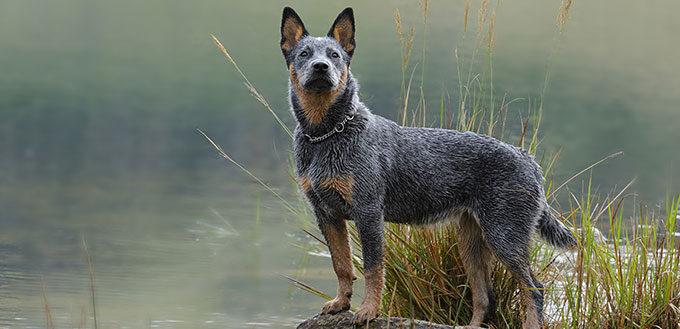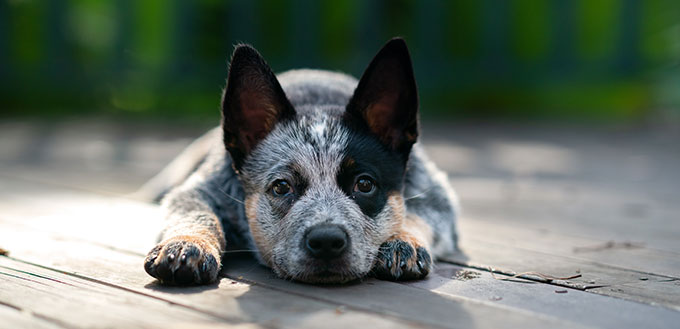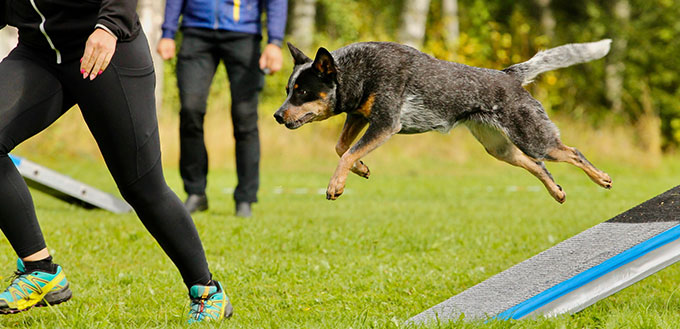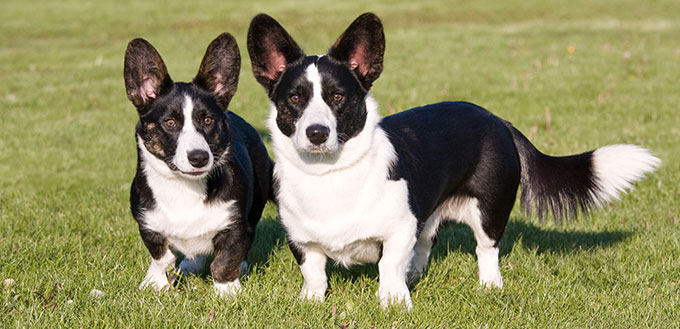A working animal through and through, the Australian Cattle Dog is one smart – and energetic – cookie. Originally bred to herd livestock in the Aussie outback, the ACD has intelligence, energy, and agility in spades. But they are also playful and loyal to their human and while they may not be the ‘sit on the sofa and cuddle’ type of pet, the Aussie has a lot to offer an active and experienced family.
We dig a little deeper into this hardy dog to discover how, with the right home, training and handling as well as a job to do, the Australian Cattle Dog can make a bonza pet.
Breed Overview
- Dog Breed Group: Herding group
- Height: Dog size – males: 18-20 inches; females: 17-19 inches
- Weight: 35-50 pounds
- Life Expectancy: 12 to 16 years life span
History of The Australian Cattle Dog
The breed we know today as the Australian Cattle Dog is the result of the search for the perfect beef cattle herding dog by settlers farming the vast Australian outback in the early 1800s. The ranches often covered thousands of square miles of land featuring rough terrain and high temperatures where the farmers and their livestock had to travel long distances. One of the key requirements was a herding animal that barked minimally, as while barking worked with sheep and more domesticated cattle, it would spook the wild cattle herds. And the English variety of cattle dogs were just not up to the job.
After much trial and error, a smooth-haired, blue merle highland collie, imported from Scotland, was crossed with a native wild dog called a dingo, and the result was a silent herding dog, which became known as a Hall’s Heeler. These heelers were subsequently crossed with Dalmatians, to bring more loyal traits and a love of horses to the breed and then again with a Kelpie, which was a black and tan sheepdog renowned for its stamina. The result was a compact and thick set dog with similar looks to the wild dingo, which was produced in blue (Queensland Blue Heeler) and the less popular red (Queensland Red Heeler). The dog was perfect for herding wild stock and had a quietly assertive if not aggressive herding technique to keep the cattle under control.
The experimentation with the breed was hailed a success and the Australian Heeler – which later became known as the Australian Cattle Dog – was much sought after by Queensland farmers and drovers for their quiet working style, obedience and sheer working endurance. By the late 1800s, the breed has become an essential part of the growth of the country’s beef industry and in 1903 the breed standard was recognized by the Cattle and Sheep Dog Club of Australia. While the official name of the breed became the Australian Cattle Dog, they are also still known as Heelers today.
The breed started to be imported to the United States in the 1950s and the breed standard was eventually accepted for registration by the American Kennel Club (AKC) in 1980, becoming eligible for showing in the Herding group by 1983. According to the AKC, the Australian Cattle Dog breed has steadily gained in popularity as a pet in the United States, particularly over the past 20 years

Breed Information
As a hardy, outdoor working dog, the Australian Cattle Dog has a long life span of up to 16 years, and can remain healthy and active well into its senior years. Here are some other key highlights about this energetic and loyal breed:
- The Australian Cattle Dog is also known by several other names, including the Australian Heeler, Blue Heelers and the Queensland Heeler. They are also referred to Halls Heeler, after Thomas Simpson Hall who first pioneered the breed in the late 19th century.
- With his high energy levels, the Australian Cattle Dog is by no means a sofa lover, preferring to be up, out and active for most of his day. This means he works best with an active family able to meet his exercise and mental stimulation needs.
- Left to his own devices, the Australian Cattle Dog has a tendency to get bored and can become mischievous, preferring to dig up your garden or chew your furniture if left alone and unexercised for too long.
- The Australian Cattle Dog is devoted to his owners and family, typically bonding himself to one person, leading to the name ‘Velcro dog’ as he likes to be physically close to his special human.
- Due to their breeding as a cattle dog, ACDs are mouthy dogs, nipping to control their ‘herd’. This means early training and socialization as a very young puppy is essential so they can interact safely and positively with your family and others who visit your home.
- The Australian Cattle Dog also has a strong prey drive, however, with effective training and the all-important early socialization, they can happily live alongside other pets. Caution must always be taken when outside the home as they still may be drawn to other animals they don’t know.
- As a hardy outdoor dog, the Australian Cattle Dog is easy to care for and requires minimal grooming, although they do ‘blow’ their coat twice a year.
- With all that energy, stamina and drive to be active, Australian Cattle Dogs are great fun for active families and make excellent candidates for dog sports, including obedience and agility activities.
Breed Appearance
Compact and muscular, the Australian Cattle Dog is a medium-sized, stocky animal that is surprisingly strong and agile. Their overall look is alert, signified by a short, sharp snout, straight ears that stand up from his well-built head and an expression that is keen and intelligent. It can be said that the Australian Cattle Dog always looks primed and ready to get on with his work!
With a slightly bushed tail, the Australian Cattle Dog breed is also distinct due to the masks they have on their faces, typically in the form of an eye patch, which can either be across one or both eyes. If the blue or red heeler has no mask, he is known as plain faced.
Size
With broad shoulders, muscular neck and a deep chest, the Australian Cattle Dog is classed as a medium-sized dog, with the male only larger than the female by an inch or two. An adult male will stand between 18 and 20 inches tall to the shoulders and both male and females will tip the scales somewhere between 30 and 50 pounds.
Coat
Designed to be weather and rain resistant, especially in extreme heat, the Australian Cattle Dog has a short and straight double coat, with the outer feeling bristly while the dense undercoat is a lot softer for insulation and to protect the skin. The fur along the neck is also slightly longer and thicker for extra protection.
Australian Cattle Dogs come in two colors for the breed standard: red or blue speckle and all Australian Cattle Dog puppies are born white, except for solid color patches on their head or back. After a few weeks their appearance will darken to either the red or blue mottle pattern that is so distinctive of the breed.
The Australian Blue Heeler colors are either blue mottled or blue specked with black, blue or tan markings on their head while their undercoat is often tan. ‘Red Heelers’ have an even red speckle all over, typically with darker red colors or markings on their head.
While not a breed standard, sometimes a chocolate and cream coat colors can occur in ACDs. Whatever the colors, no two coats on an Australian Cattle Dog are ever the same.
Fun Facts
Before we delve deeper into the world of the Australian Cattle Dog, here are just a few fun facts about this super-smart breed:
- The Australian Cattle Dog is descended from Australia’s ancient wild dog, the Dingo. Dingos are thought to have roamed the Aussie mainland for more than 4,000 years.
- The breed’s moniker ‘heeler’ comes straight from the historical fact that they were bred to literally nip at the heels of cattle as they herded livestock across the Aussie landscape.
- They may have originally come from the arid outback, but the Australian Cattle Dog is one water baby who loves nothing better than to get in the water for a good old swim!
- The Australian Cattle Dog is a tough dog to wear out and will need at least two hours fast-paced exercise a day.
- Australian Cattle Dogs – or ACDs – are also known as shadow dogs due to their devotion and loyalty to their owners. They can literally become your little shadow and won’t want to leave your side.
- All Australian Cattle Dog puppies are born white, with just one or two black markings. Thought to be a throw-back to their Dalmatian heritage, they lose their white coat a couple of weeks after birth.
- One of the world’s oldest living dogs ever recorded was a Blue Heeler. Bluey, from Victoria, Australia, was born in 1910 and died in 1939, aged 29 years and five months. Bluey was still working on a ranch as a cattle dog right up to the grand old age of 20!

Personality
Considered one of the most intelligent canine breeds, the Australian Cattle Dog is both smart and independent, giving them a personality that needs plenty of mental stimulation otherwise they can fall into mischief territory. They also have exceptional energy qualities – they were bred to herd over endless farmland, after all – and the stamina to match. This is a cattle dog that wears its heritage on its paw, and needs a job to do, to stay happy and stimulated. This means they excel at dog sports and activities, such as agility, tricks and obedience.
Originally a herding dog, the Australian Cattle Dog can however be a little over-protective – of both his ‘boss’ and his territory – as well as naturally suspicious of strangers but this does mean they also make really loyal pets to their human or human pack. He will also bond for life with his pet parent and doesn’t really like to be separated.
As a domestic pet, Australian Cattle Dogs are best suited to active, energetic families who can provide the physical and mental stimulation he needs to be happy and content. And as they are herders bred to nip and bite their charges to keep them under control, Australian Cattle Dogs do need early and consistent socialization and training to ensure this behavior doesn’t spill over into his family life, especially if you have young children or other pets.
Care
With its distinct personality traits, the energetic Australian Cattle Dog will need knowledgeable handling and care if you are to get the best out of this wonderful breed. We take a look at the care essentials you need to know if you are wanting to bring a Heeler into your family.
Training
As they are intelligent, obedient and look to their (human) pack leader to take charge, the Australian Cattle Dog breed are pretty straightforward to train. However, due to their herding instinct, high energy, and activity level, early socialization and training is an absolute must. Early socialization will ensure your Australian Cattle Dog can appropriately manage his drive to mouth, chew and nip to his toys only and to see other people and animals as friends, rather than threatening strangers or potential prey.
And this training and socialization needs to be consistent and continued to make sure he grows up into a balanced Australian Cattle Dog that is a joy to own. Supplement this training with fun activities doing agility, obstacles or obedience classes and you and your pooch will be entertained, stimulated, active and happy as well as building on the bond you and your ACD dog will undoubtedly have.
Feeding
As they are very active, athletic dogs, the blue or red heeler requires a protein-based high quality dog food to keep him sustained and ensure he gets all the nutrients he needs to support his energy and general good health. And this means his daily calorie intake will be higher than your average couch potato canine and should take into account your pet’s specific activity levels.
Australian Cattle Dogs respond well to two meals a day, which should equate to between 1.5 and 2,.5 cups of quality dog food, depending on his age, size and build, as well as how active he is. And always ensure your Australian Cattle Dog has access to plenty of fresh, clean water to keep him hydrated.
Take a look at our guide on the Best Dog Food for Blue Heelers.
Grooming
As a ranch working dog that is adjusted to extreme weather, the coat of The Australian Cattle Dog is short and straight, with a weather-resistant outer. Like most short-haired breeds, he will shed lightly all year round which can be managed with weekly brushing with a short-bristled dog brush. But you do need to be prepared for a full coat shed – or ‘blow’ – twice a year as he discharges his undercoat, which will come out in clumps. During this blow period, you will need to brush him daily to keep on top of the fur-storm and help protect your home, furniture and clothes.
As the Australian Cattle Dog coat is not excessively oily, he is not prone to smelling too bad and so only needs bathing every couple of months at the most, unless he is particularly dirty.
Check out some of our dog grooming guides, such as Brushes for Short Hair Dogs, Dog Shedding Brush, Dog Shampoo, and Tear Stain Remover for Dogs.
Health
Due to their sturdy, hardworking nature, and the fact that they were bred to work outdoors, the Australian Cattle Dog is generally a healthy breed, but they can be prone to some health conditions.
When buying or adopting one of these herding dogs, you need to be aware of the following genetic predispositions and health issues that could affect them at some point during their life:
Progressive Retinal Atrophy (PRA)
This is an eye condition that can cause loss of sight in your Australian Cattle Dog, as it gradually causes the retina to deteriorate. Early signs of PRA includes your pet’s night time vision becoming affected and is a condition that can be inherited so do make sure your new ACD pup has been screened.
Hip Dysplasia
Another inherited condition, hip dysplasia occurs when a dog’s thighbone doesn’t fit correctly into the hip joint. Your Aussie will show signs of pain and lameness as the condition progresses and is more susceptible to developing arthritis in older age. Dysplasia can also affect a dog’s elbows.
Congenital Deafness
Australian Cattle Dog puppies should be tested for congenital deafness when very young. It is an inherited condition which is often linked to genes that cause dogs to be born white or with white hairs in their coat that causes a roaning or mottled pattern.
Luxating Patellas
This is a condition where the kneecap – or patella – falls out of its normal place or dislocates. It is usually indicated if your Australian Cattle Dog temporarily skips on three legs and will then return to normal.
Osteochondrosis
A relatively common condition in young, still growing dogs, osteochondrosis is where the joint cartilage doesn’t develop as it should, leaving an area of thick cartilage which is weakened and can come loose.
Australian Cattle Dogs are also prone to allergies and skin conditions, including eczema.
Exercising
Just what do you do with a dog that has been bred to herd across vast distances? Well, today’s Australian Cattle Dogs don’t need such huge spaces, but they do need plenty of exercise each day. And this extends beyond just one walk. This is a dog that likes to chase, herd and run so providing plenty of variety and the chance to burn off all that energy is a must. Left under stimulated and under-exercised and you could have a bored, frustrated and destructive pooch on your hands.
As well as making sure he has sufficient outdoor space at home (Australian Cattle Dogs are really not apartment dogs), he will need around two hours of exercise a day, and not all at a slow walking pace. This is a breed that would thrive in a runner or outdoor adventurer’s home as he is a dog you can always take with you! And if you can give him a job to do – if not on an actual a farm but participating in dog sports such as agility – then this loyal chap will reward you in so many ways.
You may also like our article on Dog Agility Tunnel.

Adopt Don’t Shop
For the inexperienced, Australian Cattle Dogs can be a bit of a challenge, and without a full understanding of the breed, many new owners can feel a little out of their depth. Which is why you can often find a surrendered Australian Cattle Dog in rescue shelters. There is absolutely no reason why these rescue dogs can’t go on to be amazing family pets, as long as you take the time to know the breed.
So, if you think the Aussie could be a good fit for you, your lifestyle and your home, then we say ‘Adopt, Don’t Shop’ and give one of these fantastic, spunky, loyal cattle dogs a second chance.
If there are no Australian Cattle Dogs currently in your local shelters or rescue groups, the check out the Australian Cattle Dog Rescue Association, who can point you in the right direction.
Price
If you are wanting to bring an Australian Cattle Dog pup into your life, then you should expect to pay somewhere between $400 and $1,000 (less for pups from cross breedings) although puppies from a top breeding line can fetch in excess of $2,500. You also need to factor in the expense of owning a dog, from setting them up in the first year and then feeding, training and caring for them for up to 15 years as The Australian Cattle Dog has a decent life span.
Before buying an Australian Cattle Dog pup, it is essential to do your homework so you can be sure you are buying from a reputable breeder and not a puppy farm. You can search for lists of recognized breeders on the American Kennel Club website.
When viewing an Australian Cattle Dog litter, always ask questions of the breeders, such as the health of both the pups and their parents, as well as grandparents. And get to see the parents if you can. Any reputable Australian Cattle Dog breeders will want to find the very best homes for their pups and should have no problems answering your questions as well as being proactive about finding out more about your suitability as a Australian Cattle Dog owner too.
FAQs:
Q: Is an Australian cattle dog a good family dog?
A: The short answer is yes, but with the Australian Cattle Dog there are some caveats. Loyal, energetic, playful, obedient…many of the qualities of Blue Heelers mean they can bring something fun and special to your home. But they are also herders as well as protective, with a strong prey drive and can be ‘mouthy’ which can include nips and bites.
For an Australian Cattle Dog to be the best family pet they can be and to bring out all their best qualities, they need to be socialized from the get-go as a puppy, so he is used to being around children (as well as other pets) and behaving appropriately from a young age. And as with all dogs, never leave your Australian Cattle Dog unsupervised with young children. But the result of all your efforts and experience will be a loving, loyal dog that will happily spend time with and show affection to all his human pack.
Q: Are Australian cattle dogs aggressive?
A: Bred to bite at cattle heels to keep the herd where they should be, Australian Cattle Dogs are working dogs that have a tendency to nip as well as be pushy. They are also fearless and loyal so need a strong leader with experience to keep their dominance under control.
Left unchecked, this dominance can develop into aggression. However, as the Australian Cattle Dog has a high intelligence, an experienced and knowledgeable dog owner should easily be able to train out any unwanted behavior.
Q: Do Australian cattle dogs like to cuddle?
A: With their independent spirit, Australian Cattle Dogs are not known as cuddle monsters but that doesn’t mean they don’t like attention. ACDs are loyal and enjoy staying close to their human for affection. As working doggo, they just don’t like it being too over the top!
Q: Are Australian cattle dogs barkers?
A: The Australian Cattle Dog breed is not known to be a persistent barker as they are a herding breed and so their actions tend to have a purpose. Alert, brave and watchful, the Australian Cattle Dog are loyal to their owners and so can be wary of strangers, leading them to bark as a warning or alarm. But other than that, they tend not to be too vocal.
Sources:
- Australian Cattle Dog, The American Kennel Club
- Dr. B A Hampson, Physiological Responses Of The Australian Cattle Dog To Mustering Exercise, Cambridge University
- ACDs Need Consistent Training And Firm Leadership To Keep Their Noses Out Of Trouble!, Australian Cattle Dog Rescue Association







